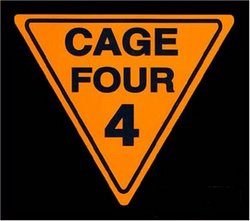Percussion viewed from a different angle
Sparky P. | composer, all around nice guy, yada yada yada | 08/20/2001
(5 out of 5 stars)
"In 1931 Edgard Varese composed what was arguably the first piece for exclusively percussion ensemble, Ionisation (at least in Western music; true, Gamalan ensembles existed for a mighty long time, but it took a while for Western composers to tap its potential). Until then percussion was used mainly in orchesrtal work and reserved mostly for support or dramatic effect but rarely on its own. Varese's piece opened the floodgates for the potential of percussion ensemble and soon many other composers wrote with a bigger percussion palet in mind, notably Bartok in his Sonata for Two Pianos and Percussion. John Cage also wrote numerous works early in his writing career, especially his Constructions from the late '30's. Not to mention of Cage's first pieces for prepared piano, which was simply an altered percussion section played by one person. Other great pieces came along and soon there were works for solo percussionist employing an arsenal of equipment, like Stockhausen's Zyklus, Xenakis's Psappha and their antithesis, The King of Denmark by Morton Feldman (where the whole piece is played with the fingertips; no mallets whatsoever are used). But in all of these mentioned works, the means are still the same: outside of ocassional rolls, the desired instrument is struck or shaken to obtain sound and then it is gone immediately until it is struck or shaken again. With notable exceptions of the keyboard (chimes and antique cymbals included) type and tympani, all other instruments fall into the catagory of "unpitched" instruments, where there really is no tempered tone value to their sound, just their feel, their presence. No harmony in the traditional sense is present when two or more percussion instruments are rolling. (Are you still with me?)
This brings us to John Cage's Four4, for four percussionists using an array of mostly unpitched percussion instruments. As with many of his other "Number pieces" written at the end of his life, sound events are bracketed to be played within a prescribed span of time, mostly single tones that enter and exit within that time. In the case of Four4, the majority of the percussion sounds are held, either rolled or shaken, for a certain amount of time. There are at least two precedences to this piece, Three2 and Six (both of which are convieniently on one disc, also offered here on Amazon). There are very few, if any, isolated strikes or thuds in this performance.
There are also ample amounts of silences in here as well, as was always Cage's philosophy. There are times where an instrument is rolled for quite a spell, coming from nowhere and submerging back into it. At times there will be just one instrument present, other times as many as four (or is it five, with silence being forever present). But remember there is really no harmony here, just coincidental relationships of the parts present. So what is happening here? There is no program of course, no real agenda, no fascinating displays of virtuosity, no questions, no answers; what is going on here is simply a revelling in sound living its own life, unecumbered by anything else around it, existing in its own terms. This disc, if you choose to accept it, should be seeked at your own risk. This is not really "dinner music", not exactly a lullaby, no soundtrack for celebration, but it isn't quite "wallpaper music" in a, say, Satie sort of way; how you listen and when is best left to your own discression. But the Freeman performance (and the Hungaroton disc I would presume) is fascinating, which is what this entire circumlocution is leading to. Just remember this is not your father's Ionisation or even Second Construction.
"
Subtle, engaging, captures the spirit of Cage!
Anthony Cornicello | West Hartford, CT, USA | 09/10/2005
(5 out of 5 stars)
"I'm quite impressed with this CD. First of all, asking anyone to record a 72-minute work is an immense task. Of course, I realize that the late "number" pieces by Cage are not techically demanding: often a time bracket consists of a single note. (Curiously, as Cage continued to write the number pieces, the materials inside a bracket often became more complex, involving groups of notes, phrases, microtonal bends.)
In this performance, Mr. Freeman captures's the Zen spirit of John Cage. Sounds appear, often without precedence or consequence: they exist for a time and fade away. And, for the most part, Mr. Freeman makes use of the soft side of percussion. Most of the sounds are very quiet - to the point where you can forget that there's a recording playing. The sounds, and the piece, are at the limits of your perception - a piece at aural periphery.
I'm glad to see these pieces appearing now on recordings. I think they represent an incredible phase of Cage's output, and the recordings being made by Glenn Freeman (and his fellow Cage interpreters) are wonderful and caring representations of these pieces."


 Track Listings (1) - Disc #1
Track Listings (1) - Disc #1